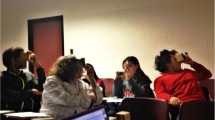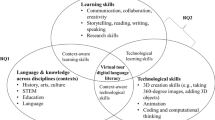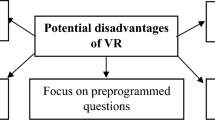Abstract
This chapter reports on the integrations of Chinese, geography, and information technology courses, with teachers from each discipline collaborating to prepare their courses, as an example of Content and Language Integrated Learning (CLIL). This empirical study employed mobile devices in the learning activities, used the situated learning strategy, and involved the students in real-life investigation in the interdisciplinary literacy curriculum. The students observed and learned in the real-life environment, and utilized mobile technologies to support their data collection and information searching. They made connections between the knowledge in the textbook and the real-life situation in the literacy-based learning activities. After they came back to the classroom, they used the data and photos they had collected to design the virtual reality of the environment they had visited in order to recall and reflect on the descriptive writing activity. This chapter primarily explored the learning effectiveness of Chinese, and found that the students made significant progress. The higher performance of the students’ VR creation, the better the outcome of their descriptive essays. It was confirmed that creating a VR project in the information technology course according to the resources collected from the actual investigation in the geography course played a role in deepening effective reflection in the pre-writing stage so that the students could perform better in the descriptive writing in the Chinese course.
Access this chapter
Tax calculation will be finalised at checkout
Purchases are for personal use only
Similar content being viewed by others
References
Allcoat, D., & von Mühlenen, A. (2018). Learning in virtual reality: Effects on performance, emotion and engagement. Research in Learning Technology, 26, 1–13.
Andujar, A., Salaberri-Ramiro, M. S., & Cruz Martínez, M. S. (2020). Integrating flipped foreign language learning through mobile devices: Technology acceptance and flipped learning experience. Sustainability, 12(3), 1110.
Bower, K. (2021). Content and Language integrated learning in England: Missed opportunities and ways forward. In U. Lanvers, A. S. Thompson, & M. East (Eds.), Language learning in Anglophone countries. Palgrave Macmillan. https://doi.org/10.1007/978-3-030-56654-8_14
Chang, S.-C., Hsu, T.-C., Chen, Y.-N., & Morris Jong, S.-Y. (2020). The effects of spherical video-based virtual reality implementation on students’ natural science learning effectiveness. Interactive Learning Environments, 28(7), 915–929. https://doi.org/10.1080/10494820.2018.1548490
Chang, S. C., Hsu, T. C., Kuo, W. C., & Jong, M. S. Y. (2020). Effects of applying a VR-based two-tier test strategy to promote elementary students’ learning performance in a Geology class. British Journal of Educational Technology, 51(1), 148–165.
Chang, S.-C., Hsu, T.-C., & Morris Jong, S.-Y. (2020). Integration of the peer assessment approach with a virtual reality design system for learning earth science. Computers & Education, 146, 103758. https://doi.org/10.1016/j.compedu.2019.103758.
Chien, S. Y., Hwang, G. J., & Jong, M. S. Y. (2020). Effects of peer assessment within the context of spherical video-based virtual reality on EFL students’ English-Speaking performance and learning perceptions. Computers & Education, 146, 103751. https://doi.org/10.1016/j.compedu.2019.103751.
Chen, Y., Smith, T. J., York, C. S., & Mayall, H. J. (2020). Google Earth Virtual Reality and expository writing for young English learners from a funds of knowledge perspective. Computer Assisted Language Learning, 33(1–2), 1–25. https://doi.org/10.1080/09588221.2018.1544151
Chittaro, L., Corbett, C. L., McLean, G. A., & Zangrando, N. (2018). Safety knowledge transfer through mobile virtual reality: A study of aviation life preserver donning. Safety Science, 102, 159–168.
Crompton, H., Burke, D., & Lin, Y. C. (2019). Mobile learning and student cognition: A systematic review of PK-12 research using Bloom’s Taxonomy. British Journal of Educational Technology, 50(2), 684–701.
Dalton-Puffer, C. (2011). Content-and-language integrated learning: From practice to principles? Annual Review of Applied Linguistics, 31, 182. https://doi.org/10.1017/S0267190511000092
Domingo, J. R., & Bradley, E. G. (2018). Education student perceptions of virtual reality as a learning tool. Journal of Educational Technology Systems, 46(3), 329–342.
Dunn, D. S. (1994). Lessons learned from an interdisciplinary-writing course: Implications for student writing in psychology. Teaching of Psychology, 21(4), 223–227.
Escorcia, D., Passerault, J.-M., Ros, C., & Pylouster, J. (2017). Profiling writers: Analysis of writing dynamics among college students. Metacognition and Learning, 12(2), 233–273.
Ferguson, C., van den Broek, E. L., & van Oostendorp, H. (2020). On the role of interaction mode and story structure in virtual reality serious games. Computers & Education, 143, 103671.
Gadelha, R. (2018). Revolutionizing education: The promise of virtual reality. Childhood Education, 94(1), 40–43.
Garrido-Iñigo, P., & Rodríguez-Moreno, F. (2015). The reality of virtual worlds: Pros and cons of their application to foreign language teaching. Interactive Learning Environments, 23(4), 453–470.
Hsieh, W.-M., & Tsai, C.-C. (2017). Taiwanese high school teachers’ conceptions of mobile learning. Computers & Education, 115, 82–95.
Hsu, T.-C. (2017). Learning English with augmented reality: Do learning styles matter? Computers & Education, 106, 137–149.
Hu, R., Wu, Y.-Y., & Shieh, C.-J. (2016). Effects of virtual reality integrated creative thinking instruction on students’ creative thinking abilities. EURASIA Journal of Mathematics, Science and Technology Education, 12(3), 477–486.
Huang, C. S. J., Yang, S. J. H., Chiang, T. H. C., & Su, A. Y. S. (2016). Effects of situated mobile learning approach on learning motivation and performance of EFL students. Journal of Educational Technology & Society, 19(1), 263–276.
Huang, H. L., Hwang, G. J., & Chang, C. Y. (2019). Learning to be a writer: A spherical video‐based virtual reality approach to supporting descriptive article writing in high school Chinese courses. British Journal of Educational Technology, 51(4), 1386–1405.
Huang, H.-M., & Liaw, S.-S. (2018). An analysis of learners’ intentions toward virtual reality learning based on constructivist and technology acceptance approaches. International Review of Research in Open and Distributed Learning, 19(1). https://doi.org/10.19173/irrodl.v19i1.2503.
Huizenga, J., Admiraal, W., Ten Dam, G., & Voogt, J. (2019). Mobile game-based learning in secondary education: Students’ immersion, game activities, team performance and learning outcomes. Computers in Human Behavior, 99, 137–143.
Huy, N. T. (2015). Problems affecting learning writing skill of grade 11 at Thong Linh high school. Asian Journal of Educational Research, 3(2), 53–69.
Johannessen, L. R. (1995). Teaching descriptive/narrative writing: Strategies for middle and secondary students. Retrieved from https://files.eric.ed.gov/fulltext/ED379665.pdf.
Kamasak, R., Özbilgin, M., Atay, D., & Kar, A. (2021). The effectiveness of mobile-assisted language learning (MALL): A review of the extant literature. Handbook of research on determining the reliability of online assessment and distance learning (pp. 194–212). IGI Global. https://doi.org/10.4018/978-1-7998-4769-4.ch008.
Kellogg, R. T. (2008). Training writing skills: A cognitive developmental perspective. Journal of Writing Research, 1(1), 1–26.
Klimova, B. (2019). Impact of mobile learning on students’ achievement results. Education Sciences, 9(2), 90.
Kumar, B. A., & Chand, S. S. (2019). Mobile learning adoption: A systematic review. Education and Information Technologies, 24(1), 471–487.
Lasagabaster, D., & Sierra, J. M. (2009). Language attitudes in CLIL and traditional EFL classes. International Journal of CLIL Research, 1, 4–17.
Lin, T.-J., & Lan, Y.-J. (2015). Language learning in virtual reality environments: Past, present, and future. Journal of Educational Technology & Society, 18(4), 486–497.
Mahan, K. R. (2020). The comprehending teacher: Scaffolding in content and language integrated learning (CLIL). The Language Learning Journal. https://doi.org/10.1080/09571736.2019.1705879.
Mansilla, V. B., Duraisingh, E. D., Wolfe, C. R., & Haynes, C. (2009). Targeted assessment rubric: An empirically grounded rubric for interdisciplinary writing. The Journal of Higher Education, 80(3), 334–353.
Merino, J. A., & Lasagabaster, D. (2018). The effect of content and language integrated learning programmes’ intensity on English proficiency: A longitudinal study. International Journal of Applied Linguistics, 28(1), 18–30.
Morrison, R. (2017). Virtual reality in the language learning classroom. The Morning Watch: Educational and Social Analysis, 44(1–2 Fall), 1–9.
Olmos-Raya, E., Ferreira-Cavalcanti, J., Contero, M., Castellanos, M. C., Giglioli, I. A. C., & Alcañiz, M. (2018). Mobile virtual reality as an educational platform: A pilot study on the impact of immersion and positive emotion induction in the learning process. EURASIA Journal of Mathematics, Science and Technology Education, 14(6), 2045–2057.
Pack, A., Barrett, A., Liang, H.-N., & Monteiro, D. V. (2020). University EAP students’ perceptions of using a prototype virtual reality learning environment to learn writing structure. International Journal of Computer-Assisted Language Learning and Teaching (IJCALLT), 10(1), 27–46.
Ramírez Balderas, I., & Guillén Cuamatzi, P. M. (2018). Self and peer correction to improve college students’ writing skills. Profile Issues in Teachers Professional Development, 20(2), 179–194.
Schott, C., & Marshall, S. (2018). Virtual reality and situated experiential education: A conceptualization and exploratory trial. Journal of Computer Assisted Learning, 34(6), 843–852.
Stavroulia, K. E., & Lanitis, A. (2019). Enhancing reflection and empathy skills via using a virtual reality based learning framework. International Journal of Emerging Technologies in Learning (iJET), 14(07), 18–36.
Sumekto, D. R., & Setyawati, H. (2018). Students’ descriptive writing performance: The analytic scoring assessment. https://doi.org/10.31227/osf.io/k2puy.
Sun, Y., & Gao, F. (2019). An investigation of the influence of intrinsic motivation on students’ intention to use mobile devices in language learning. Educational Technology Research and Development, 68(3), 1181–1198.
Sung, Y.-T., Chang, K.-E., & Liu, T.-C. (2016). The effects of integrating mobile devices with teaching and learning on students’ learning performance: A meta-analysis and research synthesis. Computers & Education, 94, 252–275.
Tilhou, R., Taylor, V., & Crompton, H. (2020). 3D virtual reality in K-12 education: A thematic systematic review. Emerging technologies and pedagogies in the curriculum (pp. 169–184). Springer.
Wang, Y.-H. (2017). Exploring the effectiveness of integrating augmented reality-based materials to support writing activities. Computers & Education, 113, 162–176.
Way, D. P., Joiner, E. G., & Seaman, M. A. (2000). Writing in the secondary foreign language classroom: The effects of prompts and tasks on novice learners of French. The Modern Language Journal, 84(2), 171–184.
Xie, Y., Ryder, L., & Chen, Y. (2019). Using interactive virtual reality tools in an advanced Chinese language class: A case study. TechTrends, 63(3), 251–259.
Yang, W. (2015). Content and language integrated learning next in Asia: Evidence of learners’ achievement in CLIL education from a Taiwan tertiary degree programme. International Journal of Bilingual Education and Bilingualism, 18(4), 361–382. https://doi.org/10.1080/13670050.2014.904840.
Yang, X., Lin, L., Cheng, P.-Y., Yang, X., Ren, Y., & Huang, Y.-M. (2018). Examining creativity through a virtual reality support system. Educational Technology Research and Development, 66(5), 1231–1254.
Acknowledgements
This study is supported in part by the Ministry of Science and Technology in the Republic of China under contract number MOST 108-2511-H-003 -056 -MY3.
Author information
Authors and Affiliations
Corresponding author
Editor information
Editors and Affiliations
Rights and permissions
Copyright information
© 2021 Springer Nature Singapore Pte Ltd.
About this chapter
Cite this chapter
Hsu, TC., Chan, CY. (2021). The Effects of Applying Virtual Reality Implementation on Chinese Writing Skill of Description. In: Lan, YJ., Grant, S. (eds) Contextual Language Learning. Chinese Language Learning Sciences. Springer, Singapore. https://doi.org/10.1007/978-981-16-3416-1_2
Download citation
DOI: https://doi.org/10.1007/978-981-16-3416-1_2
Published:
Publisher Name: Springer, Singapore
Print ISBN: 978-981-16-3415-4
Online ISBN: 978-981-16-3416-1
eBook Packages: EducationEducation (R0)




